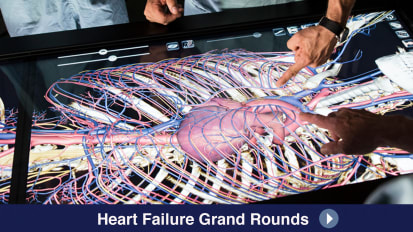Chapters
Transcript
[GENTLE MUSIC]
ANTHONY KASHOU: Welcome to Mayo Clinic's ECG segment, Making Waves, Continuing Medical Education Podcast. Join us every other week for a lively discussion on the latest and greatest in the field of electrocardiography. We'll discuss some of the exciting and innovative work happening at Mayo Clinic and beyond with the most brilliant minds in the space, and provide valuable insights that can be directly applied to your practice.
Welcome to Mayo Clinic's ECG segment, Making Waves. We're so glad you could join us. Today, we have an exciting episode planned for you as we share the release of our brand new clinical tool called Mayo Clinic Ventricular Tachycardia Calculator. We'll have an expert discussant joining us today who will help us better understand this tool and how to use it.
So let's get started. Discriminating between ventricular tachycardia, VT, and supraventricular wide complex tachycardia, an SVT, by means of a 12-lead ECG is important for achieving appropriate, high-quality, and cost-effective care in patients presenting with wide complex tachycardias. Critical patient management decisions rely on accurate and timely wide complex tachycardia differentiation into VT or SVT.
A true VT, ventricular tachycardia, misclassified as an SVT can lead to adverse, even fatal patient outcomes. Alternatively, a true SVT that's misdiagnosed as ventricular tachycardia might result in the initiation of potentially harmful medications, inappropriate invasive interventions, and increase health care expenditures.
Several decades of clinical research have brought forth an ever-expanding arsenal of ready-to-use manual ECG interpretation methods for differentiating these wide complex tachycardias. A central limitation of manual methods is their heavy reliance on the ECG interpreter for their proper execution. Hence, despite the availability of numerous manual ECG interpretation criteria and algorithms, accurate differentiation of VT and SVT continues to be problematic, especially among non-expert ECG interpreters. The application of existing manual wide complex tachycardia differentiation methods is commonly thwarted by their improper, or lack of, use in the real-life clinical practice.
Now, given the challenges of properly applying these manual algorithms in clinical practice, Mayo Clinic investigators sought to create a practical diagnostic solution that does not require a high level of expertise in ECG interpretation. Instead, a new, generalizable, accurate, and easy-to-use tool, the Mayo Clinic VT Calculator was created to assist clinicians in successfully achieving this task. And today, we're joined by Dr. Adam May to discuss the Mayo Clinic VT Calculator in further detail.
Dr. May is a cardiac intensivist and assistant professor of medicine at Washington University School of Medicine in St. Louis. Dr. May's research interests are related to the discovery, development, and refinement of innovative processes to enhance the diagnostic capabilities of automated ECG interpretation.
More specifically, his work has led to the development of automated methods designed to accurately differentiate wide complex tachycardias, including the one we're going to talk about today. His forthcoming research seeks to leverage the diagnostic capabilities of artificial intelligence techniques to better facilitate accurate rhythm analysis.
Dr. May, thank you for joining us.
ADAM MAY: Hello, Anthony. The pleasure's all mine.
ANTHONY KASHOU: Well, this is really exciting. I've had you on for a number of times and I love having you on because I continue to learn from you and we start to share more of this important problem. But today, we potentially have somewhat of a solution. And so maybe you could start by telling us what is this Mayo Clinic VT Calculator.
ADAM MAY: Yes, happy to. And indeed, it is an exciting time to offer up a new solution for a historically challenging problem. So the Mayo Clinic VT Calculator, it is a publicly available, web-based and semi-automated tool designed to help clinicians differentiate wide complex tachycardias into VT and SVT.
It is a new tool designed for clinicians, those who encounter patients with a wide complex tachycardia in their clinical practice. And with its use, clinicians will receive what we describe as a VT probability, or a likelihood that a wide complex tachycardia is actually a ventricular tachycardia. Now, this is intended to help providers differentiate wide complex tachycardias for the patients.
Now, the calculator does the following. Following the entry of readily and routinely available computerized ECG interpretation measurements, six total, three from the wide complex tachycardia ECG and then three from the baseline ECG of the patient, you can get a result of it being VT probability or likelihood that the wide complex tachycardia is indeed ventricular tachycardia.
ANTHONY KASHOU: Fascinating. And before we-- I want to ask you about the inspiration. But can you just give me-- we talk about the wide complex tachycardia ECG, the one presenting in front of us. What is considered a baseline ECG, just for our audience?
ADAM MAY: Perfect question. So for the sake of using the Mayo Clinic VT Calculator, a baseline ECG can be defined as the most proximate or nearest baseline ECG obtained before or after the recorded wide complex tachycardia event. It's really, really important. And I think you highlight that the model can be applied after the event to help facilitate management thereafter.
Now, what would you say was the inspiration for creating the Mayo Clinic VT Calculator?
ANTHONY KASHOU: Yeah, absolutely. So Anthony, you covered this quite well in the introduction. But the bottom line is, wide complex tachycardia differentiation is very hard to do. Accurate wide complex tachycardia differentiation is historically difficult with many pitfalls. These pitfalls are mostly related to deficits in ECG interpreter competency in using the available manual methods such as the Brugada algorithm or the Vereckei aVR algorithms.
Also in most cases, the available computerized ECG interpretation software algorithms that are currently embedded in products that we use today do not attempt to differentiate wide complex tachycardias into VT and SVT. They usually just provide a generic term of it being a wide complex tachycardia, which provides limited value for the user.
So we wanted to come up with an accurate solution that overcomes those barriers, and a solution that can be easily applied to almost any ECG that is encountered in clinical practice, independent of ECG interpreter competency.
ANTHONY KASHOU: Yeah. And I think you hit it on the head. It's a problem. Existing computerized software struggle with this and don't help us differentiate it. So clinically, it hurts.
And then just the competency, the proficiency of the ECG interpretation skill amongst professionals continues to wane or doesn't meet this. And yet, this is one of the most difficult tasks to perform.
So let's get right to it. How do we actually use this Mayo Clinic VT Calculator?
ADAM MAY: So great, this is a perfect question. So it basically can be broken down into a three-step process.
First and foremost, you actually need the 12 lead ECGs. It can't be applied to a single-lead tracing. Specifically, you need two ECG recordings, that being the wide complex tachycardia and also a baseline ECG. As we discussed, this baseline ECG could be the most proximate before or after the wide complex tachycardia is actually recorded.
Second, you need to visually identify and then manually enter three routinely available ECG measurements. These measurements are QRS duration, QRS axis, and T-wave axis from both the wide complex tachycardia ECG and also the baseline ECG. You input these values into the web-based calculator and then you can get your calculated VT probability.
And then third, perhaps the most important step is that you need to assimilate and integrate this resultant VT probability into your overall clinical interpretation and analysis. So if the VT calculator says that the VT probability is high, that essentially is communicating that there's a high likelihood that a wide complex tachycardia is actually a ventricular tachycardia, and thereby should increase your suspicion that the wide complex tachycardia is actually a VT.
In my clinical experience with this calculator, anything that assigns a VT probability greater than 90%, it would be highly unusual for that rhythm not to be a ventricular tachycardia.
Now, in the event that the calculator provides a low VT probability, this essentially communicates that there is a low likelihood that the wide complex tachycardia is actually a VT. And thereby, it should decrease your suspicion that the wide complex tachycardia ECG is actually a ventricular tachycardia.
And again, in my experience with this calculator, anything that the calculator assigns a VT probability less than 10%, it would be highly unusual for it not to be a supraventricular tachycardia or an SVT.
ANTHONY KASHOU: Yeah. And it's really interesting. So what I'm hearing is that so long, the manual methods will be applied. But for this one, you're taking three values from two ECGs and you're simply entering them. So you're looking at them and entering them manually. You don't actually have to apply any algorithm. And then you insert those numbers and it provides a VT probability just on demand.
And the other important thing I heard is that you have the probability, and you mentioned the high likelihood and the low likelihood. But you also want to include potentially other algorithms to help confirm your diagnosis and clinical suspicion. Is that right? You want to also include some other things as you're assessing this?
ADAM MAY: Absolutely. I think this tool is best used in the context of other tools that are available to clinicians. I would say that this tool does a lot in terms of getting clinicians closer to the actual underlying diagnosis. However, I think it needs to be supported by other clinical variables such as history of myocardial infarction or a history of structural heart disease, as well as other algorithms such as the Brugada algorithm, limb lead algorithm, Vereckei aVR algorithm.
ANTHONY KASHOU: Yeah, it's using everything. And this is an extremely helpful data point to get you started, at least.
Now I wonder, how does this tool actually perform?
ADAM MAY: Yeah, so great question. So overall, I can say that this tool performs pretty darn good. So we conducted original research on this issue. And what we determined is that there is strong overall diagnostic performance with good sensitivity and specificity for identifying VT.
On a separate validation cohort, we found that the area under the curve or AUC was 0.90. And this was featured in our recent paper entitled "VT Prediction Model." We also observed that there were strong performance metrics across a wide variety of VT probability cut points.
In subsequent research, we actually found that the algorithm actually helps clinicians in wide complex tachycardia ECG interpretation. So we found that the tool enhances both clinicians' interpretation accuracy, as well as their confidence in wide complex tachycardia differentiation.
And lastly, we have yet-to-be-published data that will demonstrate that the VT Calculator, or the VT Prediction Model, will compare favorably to existing manual methods, including the Brugada algorithm, Vereckei aVR algorithm, and the VT score.
ANTHONY KASHOU: It's incredible. And I know this has been years of work. And finally this is now available, a tool that clinicians can freely use to actually improve their accuracy and confidence. And our work together has shown that with the residents and cardiology Fellows, it does enhance their ability to do that.
And some may say, two ECGs? Well, what if I don't have one and I know there's a lot of work coming, and that's already been published to show that's not always needed. But this is a step in the right direction.
So what do you recommend for users of the Mayo Clinic VT Calculator?
ADAM MAY: Great. So I think users should use the VT calculator results as another data point to influence their final conclusion on what the wide complex tachycardia actually is, that being VT or SVT. Users should use this result with other information that can increase or decrease the post-test probability that the VT is actually present.
So this does include, as I mentioned, other algorithms such as the limb lead lead algorithm, Brugada algorithm, et cetera. It also should be incorporated with other information such as clinical variables. Do they have a history of VT? Do they have a history of a myocardial infarction? These are important clinical variables that you can add to the overall likelihood that a VT is actually present.
Bottom line is that users should use this tool as a device that will assist them in differentiating wide complex tachycardias, not as a tool that replaces their clinical judgment entirely.
ANTHONY KASHOU: Wide complex tachycardia differentiation is not an easy task. Accurate discrimination is important because it affects the way we manage our patients. While many manual approaches help us to discriminate wide complex tachycardias, they have limitations and heavily rely on the expertise of the ECG interpreter.
The Mayo Clinic VT Calculator offers a simple, easy-to-use tool to help clinicians arrive at an accurate diagnosis. We're excited to share that it is now publicly available and you can now access it by visiting mayoclinic.org and searching Mayo Clinic VT Calculator. Try it out the next time you encounter a wide complex tachycardia and let us know how it performs.
Dr. May, thank you for sharing the Mayo Clinic VT Calculator. I'm so excited to see this tool in practice now released and to see the potential value it adds to clinicians. On behalf of our team, thank you for taking the time out of your day to join us. It's always a true pleasure to have you.
ADAM MAY: You're very welcome, Anthony. It was a pleasure.
ANTHONY KASHOU: Thank you for joining us today. We invite you to share your thoughts and suggestions about the podcast at cveducation.mayo.edu. Be sure to subscribe to the Mayo Clinic Cardiovascular CME podcast on your favorite platform. And tune in every other week to explore today's most pressing electrocardiography topics with your colleagues at Mayo Clinic.
[GENTLE MUSIC]
Watch Anthony H. Kashou, M.D., a cardiovascular fellow at Mayo Clinic in Rochester, Minnesota, and Adam M. May, M.D., a cardiac intensivist at Washington University School of Medicine in St. Louis, Missouri, discuss the Mayo Clinic ventricular tachycardia calculator, a practical diagnostic solution that does not require a high level of expertise in ECG interpretation.
Related Videos





